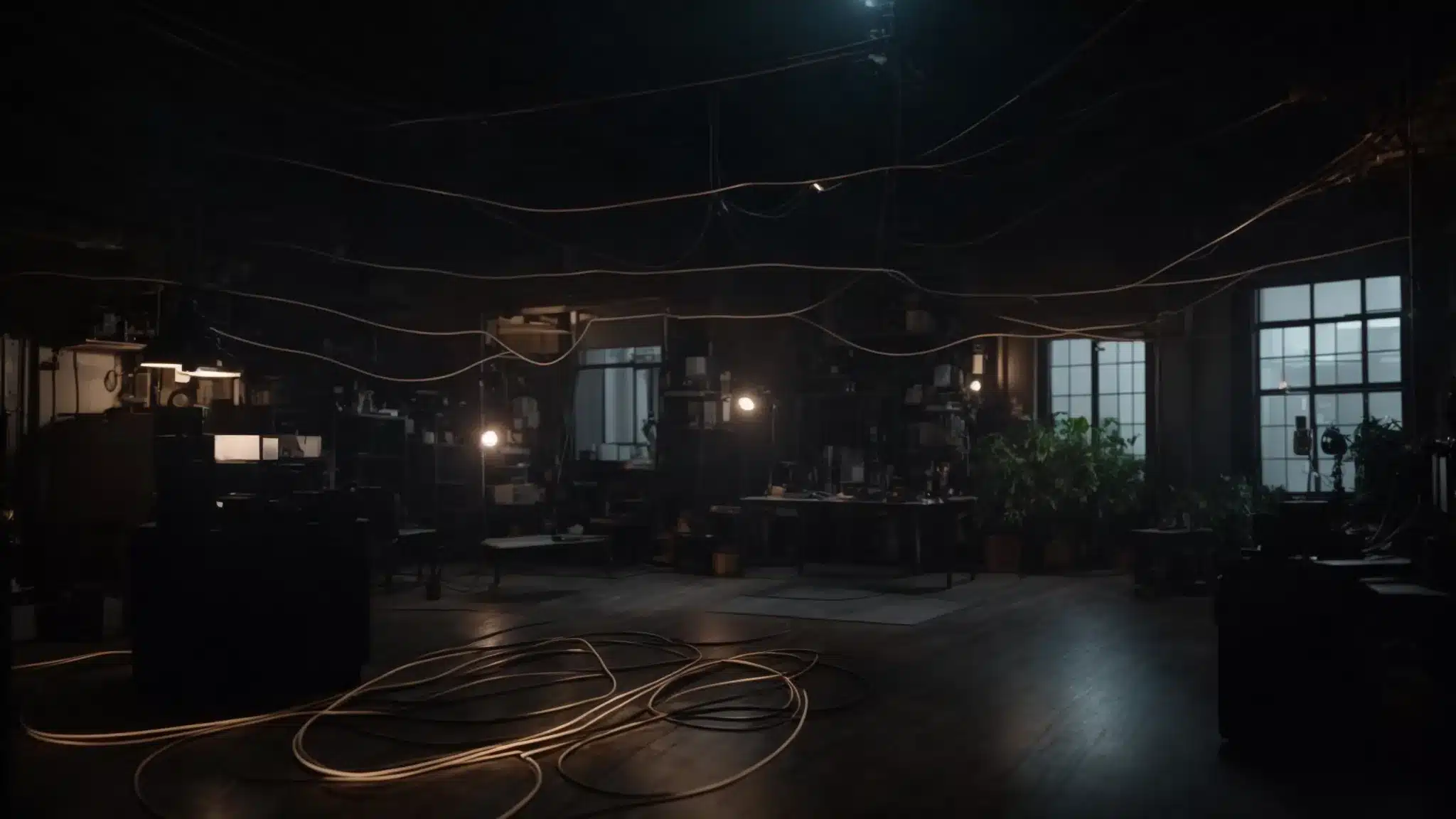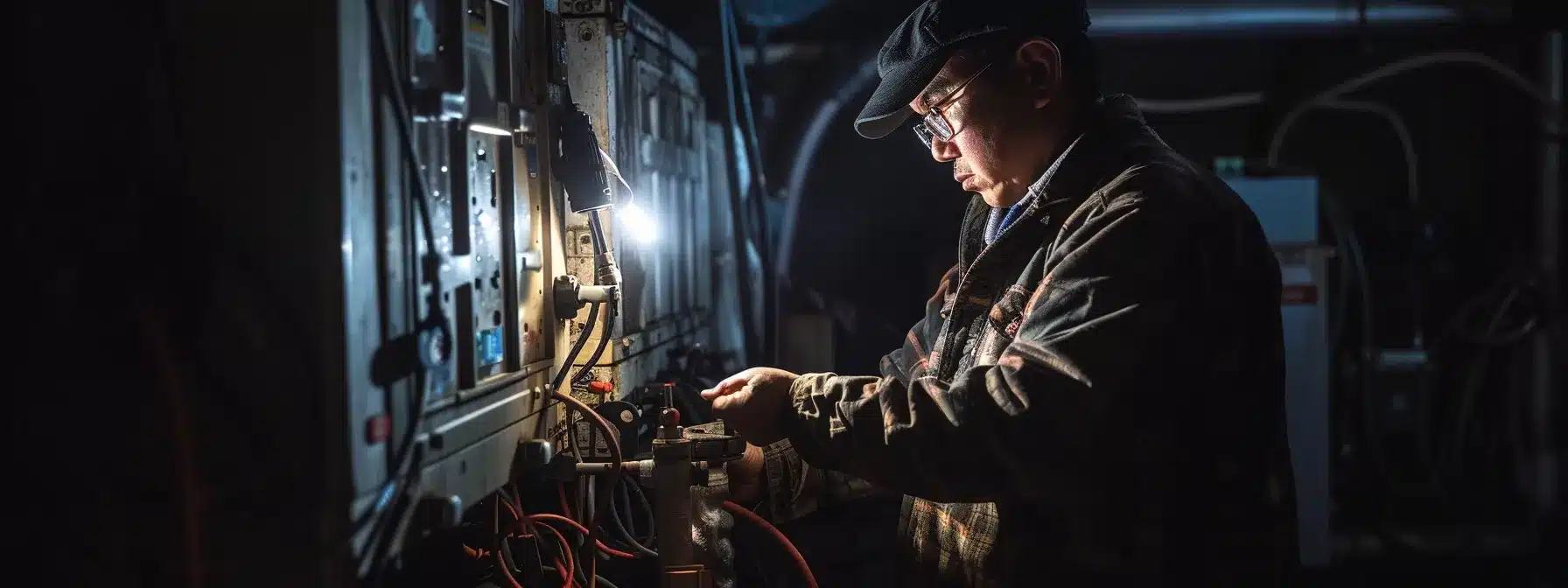Power outages can bring unexpected electrical hazards, causing stress for homeowners and businesses alike. During these interruptions, faulty electrical wiring or improper use of extension cords can lead to dangerous situations. It’s crucial to have an emergency electrician‘s number on hand and ensure your carbon monoxide detector is functioning properly. In this article, we’ll explore essential strategies to mitigate electrical risks during power interruptions, helping you stay safe and prepared.
Key Takeaways
- Exposed wires pose significant risks during power outages, requiring professional inspection
- Safe lighting alternatives like LED lanterns are crucial for preventing fire hazards
- Proper generator placement and operation are essential for avoiding carbon monoxide poisoning
- Regular maintenance of electrical systems and backup power sources enhances safety and reliability
- Educating family members on electrical safety protocols is vital for preventing accidents during outages
Identifying Common Electrical Hazards When Power Goes Out

When the lights flicker out during a power outage, electrical hazards can lurk in the shadows. From exposed wires to the temptation of using unsafe light sources, homeowners face risks that demand attention. In Lexington, KY, where snow storms can disrupt power and challenge emergency management systems, understanding these dangers becomes mission critical. This section explores common electrical threats during outages, including generator safety and the perilous mix of water and electricity. As we shift towards renewable energy, being prepared for these situations ensures both emergency electrician safety and resilience in the face of unexpected power losses.
Understanding the Risks of Exposed Wires During Outages
During power outages, exposed wires pose a significant threat to homeowners and businesses alike. These hidden hazards can emerge from damaged electrical systems, particularly after a winter storm or severe weather event. The risks increase when people attempt DIY repairs or use unfamiliar equipment during electric power interruptions.
Exposed wires can lead to electrocution, fires, or damage to valuable machinery. Even when the main power is off, residual current in capacitors or backup systems can still pose dangers. This risk is especially high in industrial settings where complex electrical systems and heavy machinery are present.
To mitigate these risks, it’s crucial to have a professional electrician inspect your property after any significant power downtime. They can identify potential hazards and ensure your electrical system is safe before power is restored. Here’s a quick guide to common wire-related hazards during outages:
The Dangers of Using Candles and Non-Electric Light Sources
When power outages strike, many folks turn to candles and other non-electric light sources for illumination. While these options seem harmless, they can pose serious risks during severe weather or natural disaster situations. Proper preparedness includes having safe, battery-powered alternatives on hand to avoid potential fire hazards.
Candles, oil lamps, and kerosene lanterns produce open flames that can easily ignite nearby flammable materials. In a crisis management scenario, where air conditioning systems are down and temperatures rise, the risk of accidental fires increases. Overturned candles or unattended flames can quickly lead to dangerous situations, especially in homes with children or pets.
Battery-operated LED lanterns and flashlights offer safer alternatives for emergency lighting. These modern options provide reliable illumination without the fire risks associated with traditional flame-based sources. By incorporating these safer lighting choices into your emergency kit, you can maintain visibility during extended outages without compromising household safety.
Generator Safety: Choosing the Right Type and Location
Selecting the right generator and placing it correctly can prevent injury and property damage during power outages. Homeowners should consider their power needs and choose between portable or standby generators, ensuring they match the electrical load of essential appliances. Proper sizing avoids overloading and potential generator failure.
Generator location is crucial for safety and efficiency. Place generators outdoors, away from windows and doors, to prevent carbon monoxide poisoning. Ensure the area is dry and well-ventilated to reduce fire risks and maintain optimal performance. Keep a first aid kit nearby in case of emergencies during generator operation.
Never connect a generator directly to your home’s wiring without a transfer switch installed by a licensed electrician. Use heavy-duty extension cords rated for outdoor use, and avoid overloading power strips. Regular maintenance and testing help ensure your generator will function reliably when you need it most.
Water and Electricity: A Risky Mix During Floods
When floods accompany power outages, the combination of water and electricity creates a dangerous scenario. Floodwaters can submerge electrical outlets, appliances, and wiring, posing serious risks of electrocution and fire. Even after the wind dies down or an ice storm passes, standing water remains a hidden threat to those attempting to restore power or navigate their homes.
During emergencies, it’s crucial to avoid entering flooded areas where electrical equipment may be present. Backup generators, while helpful, can become hazardous if exposed to water. Always keep generators elevated and protected from floodwaters to prevent electrical accidents and potential carbon monoxide poisoning.
Professional electricians play a vital role in safely assessing and restoring electrical systems after flooding. They can identify water-damaged components and ensure proper drying and testing before reactivating power. Following a flood, homeowners should prioritize electrical safety by taking these precautions:
- Turn off the main power supply if safe to do so
- Avoid using electrical devices that have been submerged
- Wait for professional inspection before restoring power
- Replace all water-damaged electrical components
- Install ground fault circuit interrupters in flood-prone areas
Power outages can strike unexpectedly, leaving homeowners vulnerable to hidden electrical dangers. Preparing your home’s electrical system before a blackout hits can significantly reduce these risks and keep your family safe.
Essential Preparations for Reducing Electrical Risks Before an Outage

Preparing for power outages involves more than just stocking up on flashlights and batteries. It’s about creating a comprehensive strategy to protect your home’s electrical system and ensure family safety during extreme weather events. From installing surge protectors to safeguard electronics against power fluctuations to maintaining smoke detectors for early fire warning, every precaution counts. Homeowners should also consider the benefits of solar energy as a backup power supply, reducing reliance on the grid during outages. Creating and practicing a family emergency plan, along with keeping essential contacts readily available, are best practices that can make a significant difference when the circuit breaker trips unexpectedly. By taking these proactive steps, families can face power interruptions with confidence and minimize potential electrical hazards.
Installing Surge Protectors to Safeguard Electronics
Surge protectors act as the first line of defense against electrical spikes that can damage sensitive electronics during power outages. These devices shield computers, TVs, and other valuable equipment from sudden voltage increases, reducing the risk of fire and equipment failure. An experienced electrician can recommend and install whole-house surge protection systems for comprehensive coverage.
Proper placement of surge protectors is crucial for maximizing their effectiveness. Homeowners should install them at key points throughout the house, including areas with high-value electronics and near potential entry points for electrical surges. This strategic placement helps mitigate hazards and protects against the “domino effect” of cascading electrical failures.
Regular maintenance of surge protectors is as important as their initial installation. Like smoke detectors, these devices require periodic checks to ensure they’re functioning correctly. Homeowners should test and replace surge protectors according to manufacturer recommendations to maintain optimal protection against electrical risks:
The Importance of Smoke Detectors and Their Maintenance
Smoke detectors serve as a critical component of a home’s safety infrastructure, especially during power outages when electrical hazards increase. These devices can detect fires caused by voltage fluctuations or damaged wiring, providing early warning even when the electrical grid fails. During storms or other events that disrupt power, properly maintained smoke detectors continue to function on backup batteries, offering crucial protection.
Regular maintenance of smoke detectors ensures their reliability during power interruptions. Homeowners should test devices monthly, replace batteries annually, and upgrade units every 10 years. This routine care helps prevent false alarms and ensures detectors will respond effectively to smoke from electrical fires or other sources, even when ventilators and other powered systems are inactive.
Strategically placing smoke detectors throughout the home enhances overall safety during outages. Install units on every level, including basements, and outside sleeping areas. For homes with solar panels or backup generators, consider additional detectors near this equipment to monitor for potential electrical fires when alternative power sources are in use.
Creating and Practicing a Family Emergency Plan
Families should create and practice an emergency plan that addresses electrical risks during power outages. This plan should outline steps to safely manage electrical loads, including shutting down sensitive equipment in home offices or small data centers. Regular drills help family members respond quickly to minimize potential hazards when commercial power fails.
The plan should account for various climate-related scenarios that could impact electrical systems. Families living in areas prone to extreme weather events should include specific protocols for securing outdoor electrical equipment and managing indoor temperatures without relying on powered climate control systems. This preparation helps reduce risks associated with overloaded circuits or improvised heating methods during extended outages.
An effective family emergency plan also includes a communication strategy for staying informed about power restoration efforts. Designating a family member to liaise with utility companies and local authorities ensures everyone receives timely updates on electrical safety concerns. This coordinated approach helps families navigate the challenges of power interruptions while minimizing exposure to potential electrical hazards.
Keeping Emergency Contacts and Information Readily Available
Maintaining a readily accessible list of emergency contacts is crucial for ensuring safety during power outages. This list should include local utility companies, electricians, and emergency services, as well as numbers for family members and neighbors. Keeping this information updated and easily visible, such as on a refrigerator or in a shared digital document, can save precious time during a crisis.
In addition to contact information, homeowners should keep important electrical system details on hand. This includes the location of main breakers, fuse boxes, and any backup power systems like generators or solar inverters. Having this knowledge readily available can help prevent accidents and improve response times during floods or other emergencies that might affect electrical systems.
For businesses and homes with servers or critical equipment, it’s essential to have a checklist of shutdown procedures and restart protocols. This information helps maintain productivity after power is restored and reduces the risk of equipment damage. Include steps for checking for carbon monoxide buildup from generators and guidelines for safely powering up sensitive electronics after an outage.
Darkness descends without warning, plunging homes into sudden silence. Now, as the power fades, your preparedness faces its ultimate test.
Effective Strategies for Staying Safe During a Power Interruption

Power interruptions can turn everyday environments into potential hazard zones, especially when it comes to electrical safety. Whether caused by lightning strikes or equipment failures, outages require careful navigation to prevent accidents. From choosing safe lighting alternatives to operating diesel generators correctly, preparedness is key. This section explores crucial strategies for maintaining safety during blackouts, covering topics from fire safety with proper illumination choices to the importance of emergency kits tailored for electrical hazards. It also delves into the safe operation of backup power sources, including natural gas generators often used in manufacturing settings, and the vital role of staying informed through reliable communication devices. By implementing these tactics, individuals and businesses can significantly reduce risks associated with sudden power losses.
Using Flashlights Instead of Candles to Prevent Fires
During a power outage, flashlights offer a safer alternative to candles for illumination. Unlike open flames, battery-powered lights eliminate the risk of accidental fires, a concern echoed by the Centers for Disease Control and Prevention. This safety measure becomes particularly crucial in areas prone to wildfires, where even a small spark can have devastating consequences.
Modern LED flashlights provide bright, long-lasting light without the hazards associated with candles. They don’t require a transfer switch or surge protector, making them ideal for use during electrical emergencies. Homeowners can strategically place flashlights throughout their homes, ensuring easy access when the power goes out unexpectedly.
Investing in rechargeable flashlights with backup batteries can further enhance preparedness for extended outages. These devices offer reliable illumination without the ongoing cost and waste of disposable batteries. By choosing flashlights over candles, families can maintain visibility while significantly reducing fire risks during power interruptions.
Guidelines for Safely Operating a Generator
Operating a generator safely during power outages requires careful attention to detail and proper knowledge. Positioning the generator outdoors, away from windows and doors, prevents carbon monoxide buildup inside the home. Ensure the area around the generator remains dry and well-ventilated to reduce fire risks and maintain optimal performance.
Before starting the generator, inspect all connections and fuel levels. Use heavy-duty, outdoor-rated extension cords to connect appliances directly to the generator, avoiding overloading circuits. Keep a flashlight handy for checking connections and monitoring the generator’s operation in low-light conditions.
Regular maintenance is crucial for generator safety and reliability. Follow the manufacturer’s guidelines for oil changes, filter replacements, and overall upkeep. Store fuel safely in approved containers away from living areas. Here’s a quick guide to generator safety essentials:
Emergency Kit Essentials: What to Include for Electrical Safety
A well-prepared emergency kit should include essential items for electrical safety during power outages. Battery-powered or hand-crank flashlights, extra batteries, and portable phone chargers ensure reliable lighting and communication. Including a battery-operated or hand-crank radio allows access to important updates and emergency broadcasts.
Electrical safety gear such as insulated gloves, non-conductive tools, and a multimeter can help identify and address minor electrical issues safely. A supply of surge protectors and power strips protects sensitive electronics when power returns. Keeping a basic first aid kit with burn treatment supplies addresses potential electrical injuries.
Waterproof containers for storing important documents and electrical devices safeguard against water damage during storms or floods. Including a portable GFCI adapter adds an extra layer of protection when using electrical equipment in damp conditions. Stocking up on glow sticks provides safe, flameless light sources for extended outages.
Staying Informed Through Battery-Powered or Hand-Crank Radios
Battery-powered and hand-crank radios serve as lifelines during power outages, providing crucial information when other communication methods fail. These devices offer access to emergency broadcasts, weather updates, and local news, helping families stay informed about the status of power restoration efforts and potential safety hazards. Unlike smartphones or internet-dependent devices, these radios remain operational for extended periods without relying on the electrical grid.
Hand-crank radios offer an additional layer of reliability, allowing users to generate power manually when batteries run low. This feature proves invaluable during prolonged outages, ensuring continuous access to information even when battery supplies dwindle. Many modern emergency radios also include built-in flashlights and USB charging ports, further enhancing their utility during electrical emergencies.
Regularly testing and maintaining these radios ensures their readiness when power interruptions occur. Storing them in easily accessible locations throughout the home, along with spare batteries, allows family members to quickly obtain information during unexpected outages. By relying on these versatile devices, households can make informed decisions about electrical safety and respond effectively to changing conditions during power disruptions.
When the lights go out, the real challenge begins. Discover how to harness alternative power sources and keep your home running smoothly during an outage.
Managing the Use of Generators and Alternative Power Sources

Power outages often prompt homeowners to turn to generators and alternative power sources, but these solutions come with their own set of risks. Proper management of these devices is crucial for maintaining electrical safety during interruptions. From ensuring correct installation and ventilation of home generators to understanding the limitations of backup power systems, careful consideration is necessary. Additionally, the process of transitioning back to main power after an outage requires specific precautions to prevent electrical accidents. By addressing these key aspects, homeowners can harness the benefits of alternative power sources while minimizing potential hazards associated with their use during emergencies.
Safe Installation and Ventilation for Home Generators
Proper installation of home generators is crucial for preventing electrical hazards during power outages. A licensed electrician should install a transfer switch to safely connect the generator to the home’s electrical system, preventing backfeeding and protecting utility workers. Homeowners must place generators outdoors, at least 20 feet away from windows, doors, and vents to avoid carbon monoxide poisoning.
Adequate ventilation is essential for generator safety and performance. Ensure the generator has ample clearance on all sides for proper airflow and heat dissipation. Avoid operating generators in enclosed spaces, including garages or carports, even with doors open. Regular maintenance, including cleaning air intakes and exhaust ports, helps maintain optimal ventilation and efficiency.
Proper grounding of generators is essential for electrical safety. Follow manufacturer guidelines for grounding procedures, which may vary depending on the generator type and local electrical codes. Consider installing carbon monoxide detectors near sleeping areas as an additional safety measure when using generators during outages. Here’s a quick guide to generator installation and ventilation best practices:
Understanding the Limits of Your Backup Power Source
Homeowners must recognize the limitations of their backup power sources to ensure safe and efficient operation during outages. Different generators and alternative power systems have varying capacities, run times, and fuel requirements. Understanding these constraints helps prevent overloading and potential damage to both the power source and connected devices.
Portable generators typically provide limited power output, suitable for running essential appliances but not entire homes. Users should prioritize critical loads and avoid connecting too many devices simultaneously. Standby generators offer more capacity but still have limits based on their size and fuel supply. Homeowners should assess their power needs and match them to appropriate backup solutions.
Alternative power sources like solar panels with battery storage also have limitations, especially during extended cloudy periods or nighttime hours. Users must monitor battery levels and adjust power consumption accordingly. Understanding these limitations allows for better planning and resource management during outages:
- Calculate total power requirements for essential devices
- Determine generator or battery system capacity
- Create a prioritized list of appliances to power
- Establish a rotation schedule for using high-draw appliances
- Monitor fuel levels or battery charge status regularly
Transitioning Safely Back to Main Power After an Outage
Transitioning back to main power after an outage requires careful steps to prevent electrical accidents. Before restoring power, homeowners should turn off all appliances and electronics to avoid potential damage from power surges. This precaution also reduces the load on the electrical system when power returns, minimizing the risk of overloads or short circuits.
Once utility power is restored, gradually reconnect devices and appliances. Start with essential items like refrigerators and heating systems, then add other devices one at a time. This approach allows the electrical system to stabilize and helps identify any potential issues before they escalate. If using a generator, follow proper shutdown procedures before switching back to main power.
After power restoration, monitor the electrical system for any signs of trouble. Watch for flickering lights, unusual sounds, or burning odors that could indicate damage or lingering issues. If any problems persist, contact a licensed electrician for a thorough inspection. Homeowners should follow these steps when transitioning back to main power:
- Turn off and unplug all devices
- Wait for utility confirmation of power restoration
- Check main breaker and reset if necessary
- Gradually reconnect appliances and electronics
- Monitor for any unusual electrical behavior
- Contact an electrician if problems persist
The storm subsides, and a flicker of light illuminates the room. With bated breath, homeowners await the full return of electricity, ready to take crucial next steps.
Steps to Take Immediately After Power Is Restored

When the lights flicker back to life after a power outage, the immediate relief can overshadow critical safety steps. Homeowners must resist the urge to simply flip switches and resume normal routines. Instead, a methodical approach to reactivating electrical systems and appliances is essential for preventing potential hazards. This process involves carefully inspecting devices for signs of damage, ensuring smoke alarms are functioning correctly, and communicating any persistent issues to utility providers. By following these crucial steps, residents can safeguard their homes and families from electrical risks that may have developed during the outage, ensuring a smooth and secure transition back to powered living.
Inspecting Electrical Appliances for Damage Before Use
After power restoration, homeowners should carefully inspect electrical appliances for any visible damage before use. Look for signs of water infiltration, scorching, or melted components that may indicate potential hazards. Pay special attention to devices that were in use when the outage occurred, as they may have suffered from sudden power loss.
Start with larger appliances like refrigerators, washing machines, and HVAC systems. Check power cords for fraying or exposed wires, and ensure plugs fit securely in outlets without wobbling. For electronic devices, inspect charging ports and adapters for any signs of damage or corrosion.
If any appliance shows signs of damage or operates unusually after power returns, discontinue use immediately and consult a professional. Prioritize safety over convenience when assessing electrical equipment following an outage. Here’s a quick guide for inspecting common household appliances:
Resetting and Testing Smoke Alarms Throughout the House
After power restoration, homeowners should immediately reset and test all smoke alarms throughout their houses. This crucial step ensures these life-saving devices function properly, as power fluctuations during outages can affect their performance. Begin by locating each smoke detector and pressing the test button to verify its alarm sound works correctly.
For hardwired smoke alarms with battery backups, check that the power indicator light is on and steady. Replace any backup batteries that may have drained during the outage to maintain continuous protection. If any alarm fails to respond or produces a weak sound, replace it promptly to maintain adequate fire safety coverage.
Consider this post-outage period an opportunity to perform a thorough smoke alarm maintenance check. Clean each detector with a vacuum attachment to remove dust or debris that may have accumulated, potentially affecting its sensitivity. Document the date of this inspection and set a reminder for regular future checks to ensure ongoing home safety.
Reporting Lingering Issues to Utility Providers for Safety
After power restoration, homeowners should remain vigilant for any lingering electrical issues and promptly report them to utility providers. Unusual sounds, flickering lights, or partial power in certain areas of the home may indicate underlying problems that require professional attention. Swift reporting of these issues helps prevent potential hazards and ensures the safety of both residents and utility workers.
When contacting utility providers, homeowners should provide detailed information about the observed issues, including their location and duration. This specificity aids technicians in diagnosing and addressing problems more efficiently. Homeowners should also inform providers of any temporary repairs or alterations made during the outage to ensure proper assessment and restoration of the electrical system.
Utility companies often prioritize reports based on severity and potential safety risks. By accurately describing lingering issues, homeowners contribute to effective resource allocation and faster resolution of electrical problems. This proactive approach to reporting helps maintain the integrity of the power grid and reduces the likelihood of future outages or electrical accidents in the community.
The lights flicker back to life, but the work isn’t over yet. Now’s the time to fortify your home against future electrical surprises.
Preventing Future Electrical Hazards and Enhancing Readiness

Safeguarding against future electrical hazards and bolstering preparedness for power interruptions involves a multifaceted approach. By implementing regular maintenance routines, educating household members on crucial safety protocols, and strategically upgrading home infrastructure, families can significantly reduce their vulnerability to electrical risks during outages. These proactive measures not only enhance safety but also foster a culture of readiness, ensuring that when the lights go out, everyone knows exactly what to do. From routine system checks to smart home improvements, each step taken contributes to a more resilient and secure living environment, capable of weathering unexpected power disruptions with confidence.
Regular Maintenance Checks on Electrical Systems and Backups
Regular maintenance checks on electrical systems and backup power sources form the backbone of a robust safety strategy. Homeowners should schedule annual inspections with licensed electricians to assess wiring, circuit breakers, and grounding systems for potential issues. These professionals can identify wear and tear, outdated components, or code violations that might pose risks during power outages.
Backup power systems, including generators and battery banks, require consistent attention to ensure reliability when needed most. Owners should perform monthly tests on these devices, checking fuel levels, battery charge status, and overall functionality. This routine helps prevent unexpected failures during actual emergencies and extends the lifespan of backup equipment.
Maintenance checks should also include a review of surge protection devices and uninterruptible power supplies (UPS) for critical electronics. Homeowners can test these units according to manufacturer guidelines, replacing them as needed to maintain optimal protection against power fluctuations. By prioritizing regular maintenance, families create a safer electrical environment and improve their readiness for future power interruptions.
Educating Family Members on Electrical Safety Measures
Educating family members on electrical safety measures is crucial for preventing accidents during power outages. Parents should teach children about the dangers of downed power lines, frayed cords, and water near electrical devices. Regular family discussions can reinforce these important safety concepts and help everyone stay alert to potential hazards.
Hands-on demonstrations can effectively illustrate electrical safety principles. Show family members how to properly use surge protectors, unplug appliances during storms, and identify signs of electrical problems. Encourage questions and create an open dialogue about electrical safety to ensure everyone feels comfortable reporting concerns.
Develop a family emergency plan that includes specific roles and responsibilities during power outages. Assign tasks such as checking on neighbors, monitoring weather updates, and managing backup power sources. Practice this plan regularly to ensure everyone knows their part in maintaining electrical safety during interruptions:
- Designate a family safety coordinator
- Create a checklist for power outage procedures
- Establish a communication plan for emergencies
- Conduct quarterly family safety drills
- Review and update the plan annually
Investing in Home Improvements for Better Power Outage Resilience
Investing in home improvements can significantly enhance a household’s resilience during power outages. Installing a whole-house surge protector safeguards all electrical systems and appliances from voltage spikes when power returns. Upgrading to smart circuit breakers allows remote monitoring and control of electrical loads, helping prevent overloads during outages.
Improving home insulation and weatherproofing helps maintain comfortable temperatures during extended power losses. This reduces reliance on electrical heating or cooling systems and minimizes the risk of pipes freezing in winter outages. Consider installing energy-efficient windows and doors to further enhance temperature regulation and reduce overall energy consumption.
Implementing a backup power system tailored to specific needs provides crucial electricity during outages. Options range from portable generators to permanent standby systems or solar panels with battery storage. When selecting a backup power solution, consider factors such as fuel availability, maintenance requirements, and local regulations:
Conclusion
Mitigating electrical hazards during power interruptions requires vigilance, preparation, and education. Homeowners must prioritize safety by installing surge protectors, maintaining backup power systems, and regularly inspecting electrical equipment. Families should develop and practice emergency plans, ensuring everyone knows how to respond when the lights go out. By investing in home improvements and staying informed about potential risks, households can significantly reduce their vulnerability to electrical accidents and enhance their resilience during power outages.

